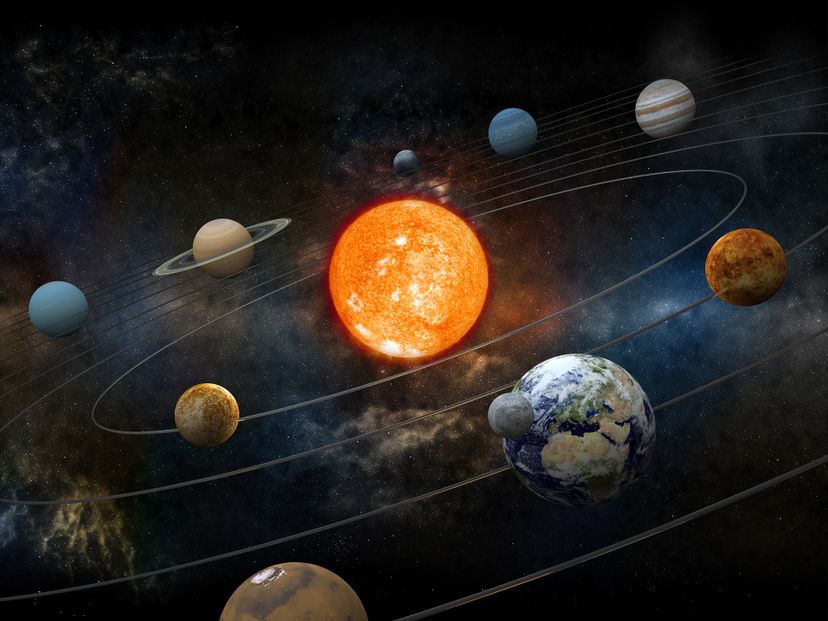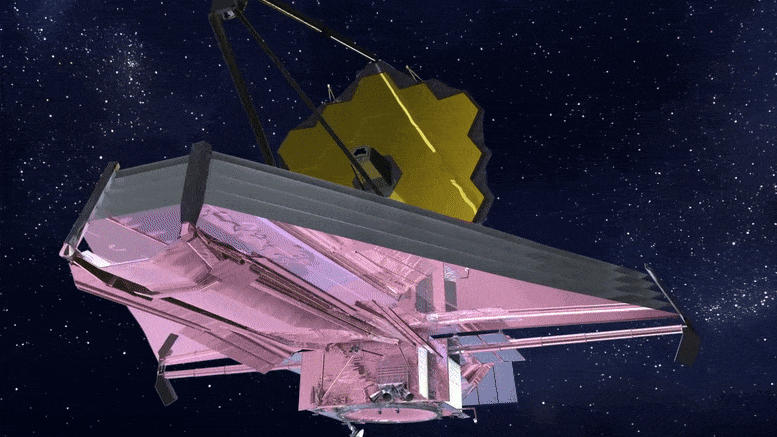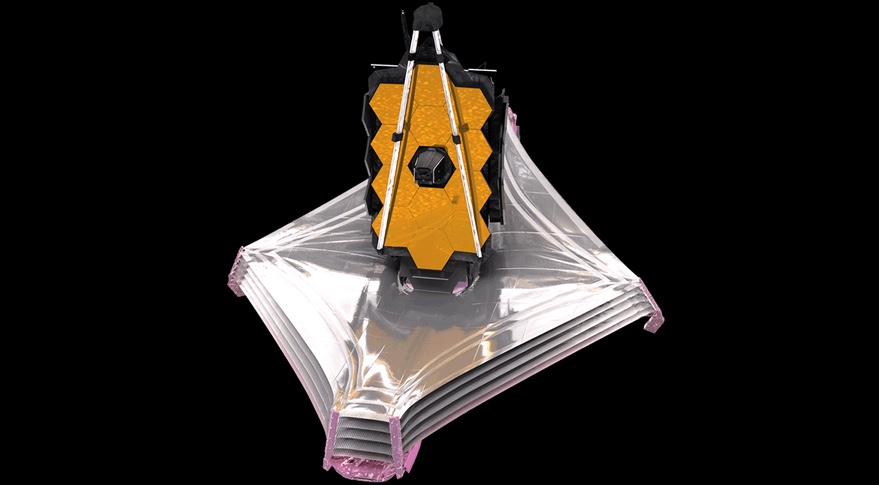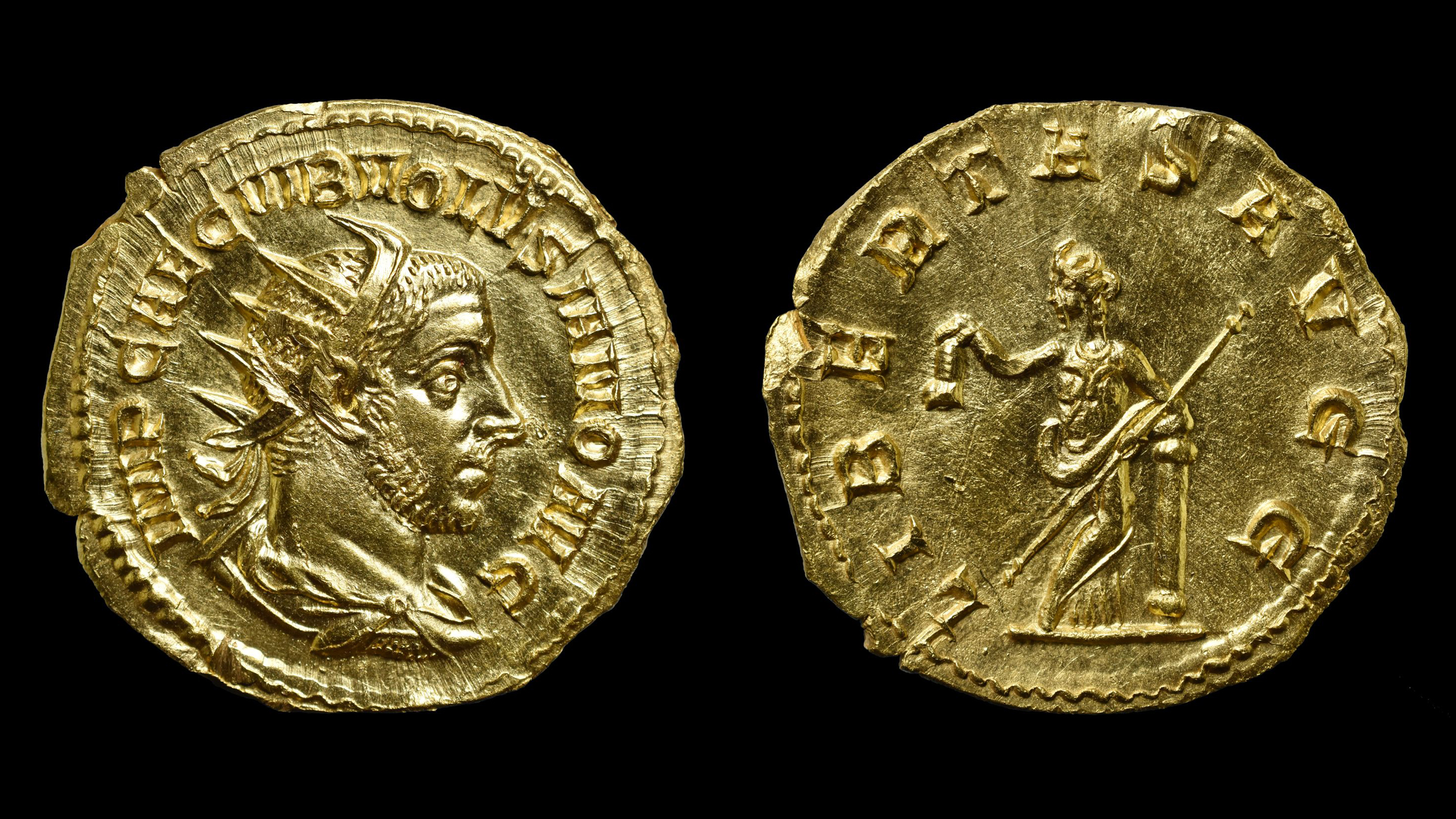
The outer planets are also known as “gas giants” (Jupiter and Saturn) and “ice giants” (Uranus and Neptune), due to their compositions. adventtr / Getty Images
Venturing far beyond our terrestrial home, the enigmatic outer planets of our solar system await, shrouded in mystery. As we gaze upon their colossal sizes, mesmerizing rings, intriguing moons and violent atmospheres, we are compelled to unravel the secrets they hold. This blog post will take you on a fascinating journey through the realm of the gas giants and their celestial dance, exploring the unique characteristics of Jupiter, Saturn, Uranus and Neptune, and delving into the potential for life on their moons.
Embark on an interstellar adventure as we uncover the extraordinary weather patterns, marvel at the cosmic ballet of moons and rings and glimpse into the future of outer planet exploration. Along the way, we will ponder the search for exoplanets and their potential similarities to our distant planetary neighbors. Hold on tight as we traverse the outer reaches of our solar system and expand our understanding of these enigmatic worlds.
Short Summary
- Explore the outer planets of our solar system to uncover new insights into planetary formation and evolution.
- Jupiter, Saturn, Uranus and Neptune boast captivating atmospheres with powerful storms, moons with potential for life and intricate systems of rings.
- The search for exoplanets offers a unique insight into discovering forms of life beyond our own solar system.
The Realm of the Gas Giants
Beyond the asteroid belt lies a realm vastly different from the rocky inner planets (Mercury, Venus, Mars and our home planet). Among the four outer planets — Jupiter, Saturn, Uranus and Neptune — are colossal gas giants with distinct characteristics and features that continue to captivate our imagination. Composed primarily of hydrogen and helium (with some methane, water and ammonia in the mix), these Jovian planets possess vast atmospheres, rocky cores, numerous moons and, in some cases, intricate systems of rings. In contrast, a dwarf planet, though not found in this specific context, is a smaller celestial body that shares some similarities with these gas giants.
As we delve deeper into the outer solar system, we will uncover the unique traits of each gas giant, exploring their stormy atmospheres, icy compositions and enigmatic moons. The sheer size and complexity of the gas giants make them difficult to comprehend, as their nature diverges significantly from the terrestrial planets with which we are familiar. Nevertheless, their peculiar characteristics offer tantalizing clues about the formation and evolution of our solar system.
As we journey through the realm of the gas giants, we will witness the colossal planet Jupiter, the ringed beauty Saturn, the tilted world Uranus and the mysterious blue giant Neptune, each with a story to tell.
Jupiter: The Colossal Planet
Boasting an atmosphere composed primarily of hydrogen and helium, Jupiter, the largest planet in our solar system, reigns supreme with its massive size and impressive characteristics. Bands of ammonia clouds, which display a vivid array of colors, adorn Jupiter’s upper atmosphere. The most famous feature of Jupiter’s stormy skies is the Great Red Spot, a colossal storm that has been raging for at least a century. This giant storm has decreased in size over the years, but it was once so immense that it could fit three Earth-sized planets within its boundaries. Now, it can only fit one Earth.
The colossal size of Jupiter is not its only claim to fame; its more than 75 known moons hold many secrets waiting to be discovered. Among these satellites are the four Galilean moons: Io, Europa, Ganymede, and Callisto. Named after astronomer Galileo Galilei, these Galilean moons possess unique characteristics and potential for life (particularly Europa). From the volcanic landscape of Io to the icy oceans of Europa, these moons are prime targets for future exploration and may hold the key to understanding the origins of life in our solar system.
Saturn: The Ringed Beauty
Saturn, the second-largest planet in our solar system, captivates stargazers with its exquisite rings. These stunning rings — composed of ice, dust and rocks — encircle the planet, creating a celestial spectacle like no other. The origin of Saturn’s rings remains a subject of scientific debate, with hypotheses suggesting that they were either remnants of a disrupted moon or material that failed to coalesce during the planet’s formation. Regardless of their origin, the rings of Saturn remain one of the most iconic features of our solar system.
Complementing its mesmerizing rings, Saturn also boasts a collection of more than 100 moons, each with unique features and landscapes. Among these satellites is Titan, Saturn’s largest moon and a fascinating world in its own right. Larger than Earth’s moon and even the planet Mercury, Titan is enveloped in a thick atmosphere and possesses liquid methane lakes on its surface. The intriguing characteristics of Titan and Saturn’s other icy satellites offer a wealth of opportunities for future exploration and the potential discovery of life beyond Earth.
Uranus: The Tilted World
Venturing further into the outer solar system, we encounter Uranus, a gas giant with a unique twist. Unlike any other planet in our solar system, Uranus, which has a nearly 90-degree tilt — rotates horizontally, with its poles almost directly facing the sun. This peculiar tilt gives rise to extreme seasonal changes, as one pole basks in sunlight for decades while the other is plunged into darkness. The icy composition of Uranus sets it apart from the gas giants, as it contains a higher percentage of water, ammonia and methane in its atmosphere. (Neptune is also an ice giant.)
Uranus has 27 moons, each named after characters from Shakespeare’s plays and Alexander Pope’s poems. Among these satellites, the five largest — Miranda, Ariel, Umbriel, Titania and Oberon — display unique features and landscapes, such as Miranda’s chaotic terrain and Ariel’s bright icy surface.
The peculiar characteristics of Uranus and its moons provide a fascinating glimpse into the diversity of celestial bodies in our solar system and the potential for life in the most unexpected places.
Neptune: The Mysterious Blue Giant
The mysterious blue giant Neptune, the most distant of the gas giants, completes our journey through the realm of the outer planets. Its enigmatic blue hue is primarily attributed to the presence of frozen methane in its atmosphere. The extreme cold at the top of Neptune’s clouds reaches an average temperature of minus 200 degrees Celsius (minus 328 degrees Fahrenheit), making it one of the coldest places in our solar system. Despite its frigid climate, Neptune’s atmosphere has some of the most powerful winds, reaching speeds of 1,100 mph (1,700 km/h), more than the speed of sound.
Neptune has 14 known moons, including its largest moon, Triton. Triton is an intriguing world, as it orbits Neptune in a retrograde motion, opposite to the planet’s rotation. This captive moon also boasts geysers that spout nitrogen gas, further adding to the mystique of this distant world.
The exploration of Neptune and its moons holds the potential for uncovering new insights into the formation and evolution of our solar system, and perhaps even the existence of life in these far-flung celestial realms.
Life Beyond the Asteroid Belt
The prospect of life beyond the asteroid belt has captivated the imagination of scientists and space enthusiasts alike. As we continue to explore the outer planets and their moons, we uncover tantalizing clues pointing to the potential for life in these distant worlds. The moons Europa and Titan, in particular, have garnered significant attention due to their unique characteristics and the possibility of harboring liquid water.
Researchers believe that Europa, one of Jupiter’s Galilean moons, has a subsurface ocean of liquid water beneath its smooth layer of ice, as well as an ongoing source of energy from tidal forces from Jupiter. Saturn’s moon Titan possesses a thick atmosphere and liquid methane on its surface, and its subsurface ocean might make it another intriguing candidate for extraterrestrial life.
As we continue to explore these distant celestial bodies, the possibility of finding life beyond the asteroid belt becomes an ever more tantalizing prospect.
Atmospheres and Weather Patterns
The outer planets have diverse and extreme weather patterns, shaped by their substantial atmospheres composed largely of hydrogen and helium gas. From Jupiter’s Great Red Spot to Neptune’s Great Dark Spot, these gas giants exhibit powerful storms and winds that put even the most ferocious terrestrial hurricanes to shame.
Additionally, the outer planets experience drastic seasonal changes, such as Uranus’ extreme inclination and Neptune’s extended seasons. The exploration of these tempestuous atmospheres provides a fascinating insight into the dynamic forces at play in the outer solar system.
Jupiter’s Stormy Skies
Jupiter’s turbulent atmosphere is characterized by its ammonia clouds, which, alongside ice and water, create the planet’s distinctive coloration. Organized into bands of different colors, these clouds give Jupiter its iconic striped appearance. The most striking feature of Jupiter’s stormy skies is the Great Red Spot, a colossal storm that has raged for more than a century. This massive storm is so immense that it could fit one Earth-sized planet within its boundaries. Jupiter has an about 10-hour day — making it the shortest among our solar system — and it takes 12 Earth years to travel around the Sun. Beyond its Great Red Spot, Jupiter’s atmosphere is home to numerous smaller storms and powerful winds, which can reach speeds of up to 539 km/h (335 mph) at the equator. The interaction between the atmosphere and the magnetic field of the planet gives rise to the colorful bands that encircle Jupiter, further adding to the mystique of this colossal planet.
Saturn’s Banded Clouds
Saturn’s atmosphere, like Jupiter’s, is composed predominantly of hydrogen and helium, with bands of clouds displaying various hues, including white, yellow, brown and red. The interaction between the atmosphere and Saturn’s magnetic field formed bands, resulting in a visually striking display that encircles the planet. Saturn’s atmosphere is also known to experience occasional storms, including the renowned Great White Spot, which tends to appear every 30 years or so.
Despite its turbulent atmosphere, Saturn appears to experience less turbulence and fewer storms than Jupiter. However, scientists have observed the presence of thunder and lightning within Saturn’s storms, providing a striking contrast to the serene appearance of its banded clouds.
The exploration of Saturn’s atmosphere offers a fascinating glimpse into the dynamic forces at play in the outer solar system and the potential for life on its icy moons.
Uranus’ Extreme Seasons
Uranus, with its unique tilted rotation, experiences some of the most extreme seasonal changes in the solar system. Its extreme axial tilt of 97.77 degrees results in the Sun shining directly on one pole for 42 years, while the other pole is plunged into darkness for the same duration. This peculiar orientation gives rise to drastic seasonal variations, as one hemisphere basks in constant sunlight while the other is shrouded in darkness.
The atmosphere of Uranus is composed primarily of hydrogen and helium, with some methane and even smaller amounts of ammonia and water. This composition, combined with its unusual axial tilt, results in a dynamic atmosphere characterized by extreme seasonal changes and powerful winds.
The exploration of Uranus’ atmosphere and its extreme seasons provides an intriguing look at the dynamic forces shaping the outer planets and the potential for life on their moons.
Neptune’s Powerful Winds
Neptune, the most distant gas giant in our solar system, is home to some of the most powerful winds ever observed. Faster than the speed of sound, these winds are more powerful than those on any other planet in our solar system, including Jupiter and Saturn. Neptune’s atmosphere is primarily composed of hydrogen and helium, with some methane present, which absorbs a significant amount of the red light in the atmosphere, giving the planet its distinctive blue color.
The extreme cold at the top of Neptune’s clouds, reaching average temperatures of as minus 200 degrees Celsius (minus 328 degrees Fahrenheit), adds to the planet’s mysterious nature.
Moons and Rings: A Cosmic Ballet
Together, the outer planets of our solar system are accompanied by a staggering (and approximate) 203 moons, each with unique features and landscapes. These celestial satellites range from small, irregularly shaped bodies to massive worlds with geologically active surfaces and the potential for life. The intricate dance of these moons and their interactions with the gas giants’ rings provide a captivating spectacle, offering a glimpse into the complexity and diversity of our solar system, which consists of eight planets.
The exploration of the inner and outer planets’ rings, composed of particles of dust and ice, offers a mesmerizing display of celestial choreography. Each planet’s rings interact with one another and their moons in complex ways, influenced by the gravitational forces of their host planets. The study of these fascinating celestial bodies provides invaluable insights into the dynamic forces at play within our solar system and the potential for life on their moons.
Jupiter’s Galilean Moons
The four Galilean moons of Jupiter, named after the Italian astronomer Galileo Galilei who discovered them in 1610, are among the most fascinating celestial bodies in our solar system. Each of these moons — Io, Europa, Ganymede, and Callisto — possesses unique characteristics, offering a wealth of opportunities for future exploration and the potential discovery of life.
Io, the innermost of the Galilean moons, is the most volcanically active body in the solar system, with a thin atmosphere composed of sulfur dioxide and a surface covered in sulfur and silicate rock. Europa, on the other hand, might possess a subsurface ocean of liquid water beneath its icy crust, making it a prime target for the search for extraterrestrial life. The presence of icy materials on Europa’s surface further supports this possibility.
Ganymede, the largest moon in the solar system, and Callisto, the most heavily cratered body in the solar system, also hold secrets waiting to be discovered.
Saturn’s Icy Satellites
Saturn’s 146 moons showcase a diverse range of features and landscapes, from the Earth-like Titan to the icy surfaces of Enceladus and Rhea. A thick atmosphere and liquid methane lakes, rivers and clouds envelop Titan, Saturn’s largest moon.. Meanwhile, the icy surfaces of Saturn’s other moons, such as Enceladus with its geysers, present a fascinating contrast to the gas giant’s banded atmosphere and stunning ring system.
In addition to Titan and Enceladus, Saturn’s other moons — such as Mimas, Dione and Tethys — offer a wealth of opportunities for future exploration and the potential discovery of life. As we continue to study these icy satellites, we gain a deeper understanding of the forces that have shaped the outer planets and their moons, and the potential for life on these distant celestial bodies.
Uranus’ Shakespearean Satellites
Uranus’ 27 moons — some of which get their names from characters inShakespeare’s plays — each possess unique characteristics and features, adding to the planet’s mystique. Among these satellites, the five largest — Miranda, Ariel, Umbriel, Titania and Oberon — display unique features and landscapes, such as Miranda’s chaotic terrain and Ariel’s bright icy surface.
The exploration of Uranus’ moons offers a fascinating glimpse into the diversity of celestial bodies in our solar system and the potential for life in the most unexpected places. As we continue to study these enigmatic worlds, we gain a deeper understanding of the forces that have shaped the outer planets and their moons, and the potential for life on these distant celestial bodies.
Neptune’s Captive Moon Triton
Neptune’s largest moon, Triton, is an intriguing world with a captivating story to tell. Scientists believe that Neptune, which orbits the planet in a retrograde motion, is a captured moon, possibly originating from the Kuiper Belt. This captive moon also boasts geysers that spout nitrogen gas, further adding to the mystique of this distant world.
The exploration of Triton and Neptune’s other moons holds the potential for uncovering new insights into the formation and evolution of our solar system, and perhaps even the existence of life in these far-flung celestial realms. As we continue to study these enigmatic worlds, we gain a deeper understanding of the forces that have shaped the outer planets and their moons, and the potential for life on these distant celestial bodies.
The Search for Exoplanets
The ongoing search for planets outside our solar system, particularly gas giants similar to the outer planets, offers a tantalizing glimpse into the potential diversity of celestial bodies in the universe. Since the initial discovery of exoplanets in 1992, scientists have detected thousands through a multitude of methods, including space telescopes like Spitzer and Hubble. As we continue to identify and study these distant worlds, we gain invaluable insights into the formation and evolution of planetary systems, and the potential for life elsewhere in the cosmos.
The search for exoplanets not only expands our understanding of the universe, but also provides a context for the study of our own solar system. By uncovering the characteristics and potential habitability of these distant worlds, we can better understand the forces that have shaped the outer planets and their moons, and the potential for life in the most unexpected places.
The Future of Outer Planet Exploration
As we look toward the future of outer planet exploration, a wealth of opportunities awaits. Upcoming missions, such as the Europa Clipper and the Titan Dragonfly, promise to bring us even closer to understanding the potential for life on these distant moons and the origins of our solar system. These missions, along with future crewed expeditions to the outer planets, have the potential to uncover new forms of life and shed light on the evolution of life on Earth.
The exploration of the outer planets and their moons is an ongoing journey, offering a wealth of knowledge about the formation and evolution of our solar system, the potential for life in the most unexpected places, and the sheer diversity of celestial bodies in the cosmos. As we continue to study these enigmatic worlds, we deepen our understanding of the forces that have shaped them and the potential for life on these distant celestial bodies.
Summary
We have embarked on a fascinating journey through the realm of the gas giants, exploring the unique characteristics of Jupiter, Saturn, Uranus and Neptune, and delving into the potential for life on their moons. From the colossal storms of Jupiter’s Great Red Spot to the enigmatic blue hues of Neptune, the outer planets of our solar system have captivated our imagination and fueled our desire to understand the cosmos.
As we continue to probe the depths of our solar system and beyond, we are reminded of the vastness and complexity of the universe, and the limitless potential for discovery. The exploration of the outer planets and their moons offers a tantalizing glimpse into the formation and evolution of celestial bodies and the potential for life in the most unexpected places. As we venture further into the unknown, we are driven by an insatiable curiosity and a desire to unravel the mysteries of the cosmos, one celestial body at a time.
This article was created using AI technology, then fact-checked and edited by a HowStuffWorks editor.
Frequently Asked Questions About the Outer Planets
What are the outer planets?
The outer planets of our solar system consist of Jupiter, Saturn, Uranus and Neptune; all four are gas giants made up primarily of hydrogen and helium, with thick gaseous outer layers and liquid interiors. They orbit farther away from the Sun than the inner planets and have multiple moons as well as rings of dust and other particles.
What are four facts about the outer planets?
The outer planets are a fascinating group of celestial objects that share the same characteristics: They all contain rings, have gaseous and icy surfaces, have many moons around them and are located farthest away from the Sun.
What are the four outer planets also called?
The four outer planets of our solar system – Jupiter, Saturn, Uranus and Neptune – are also known as the Jovian planets or gas giants due to their immense size and composition.
These planets are much larger than the terrestrial planets, and contain mostly gas and ice.
What are six characteristics of outer planets?
The outer planets of our solar system are characterized by their longer orbits, faster spins, a composition of gaseous and liquid elements, numerous moons and distinct rings. These gas giants are composed primarily of hydrogen and helium, and they offer an impressive cosmic spectacle compared to the more rocky inner planets.
Therefore, these features make the outer planets quite unique in our solar system.
What are the primary components of the atmospheres of gas giants?
The atmospheres of gas giants are primarily composed of hydrogen and helium, accompanied by trace amounts of methane and ammonia. Thus, these four components make up the primary components of these planets’ atmospheres.
Note: This article have been indexed to our site. We do not claim legitimacy, ownership or copyright of any of the content above. To see the article at original source Click Here













